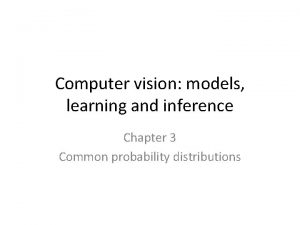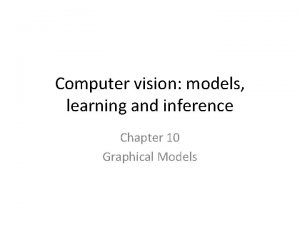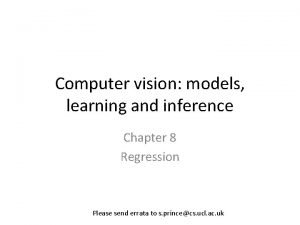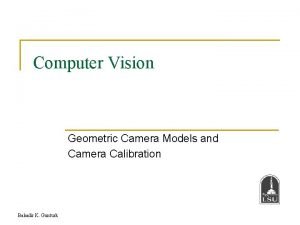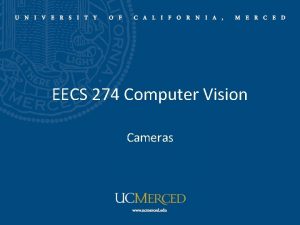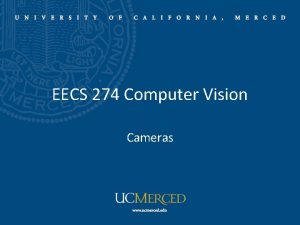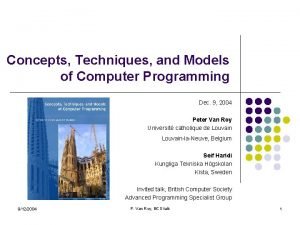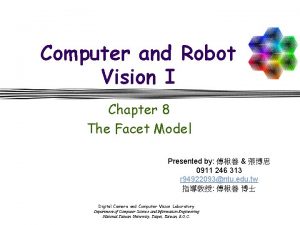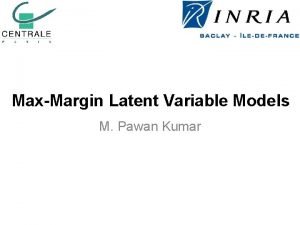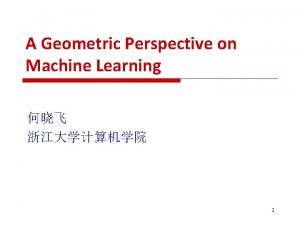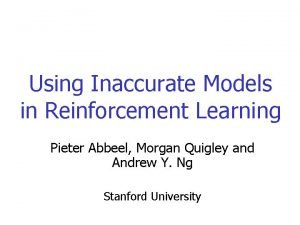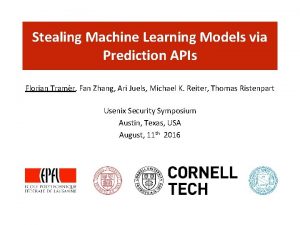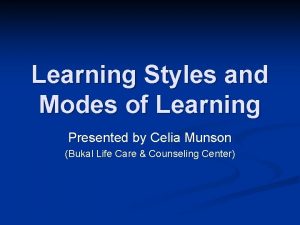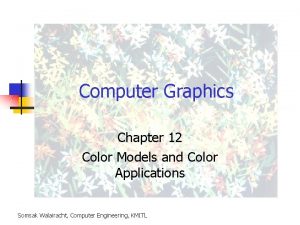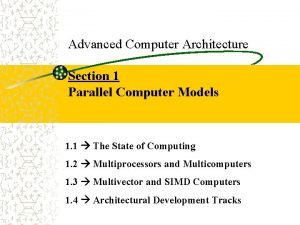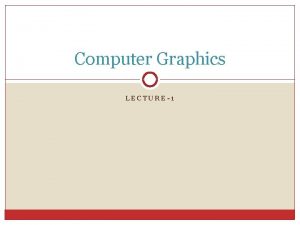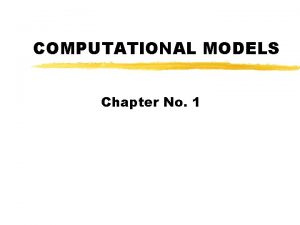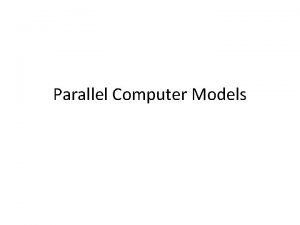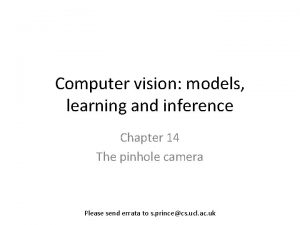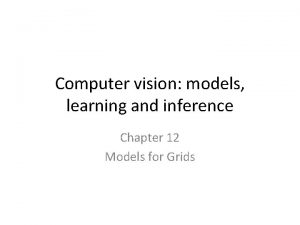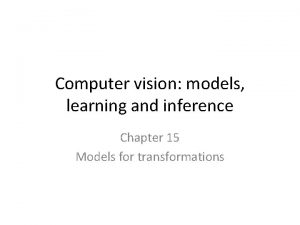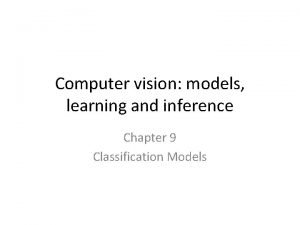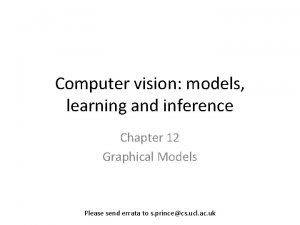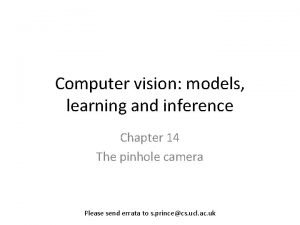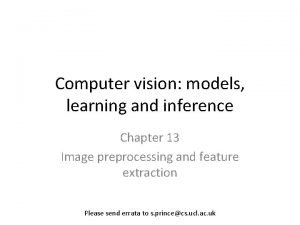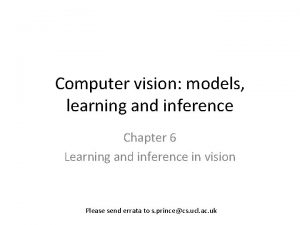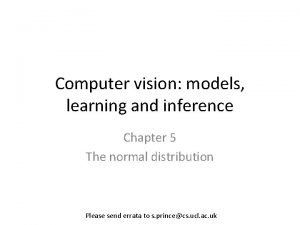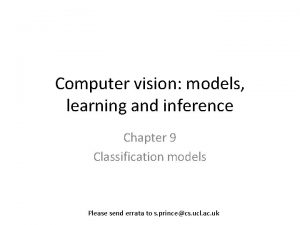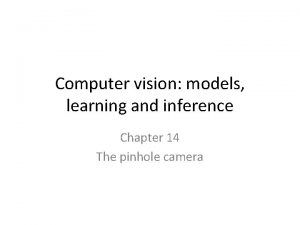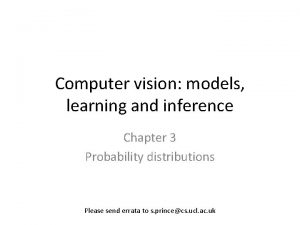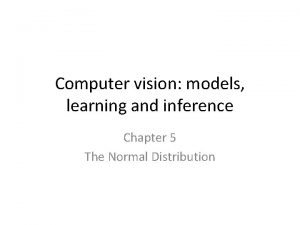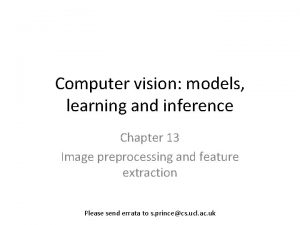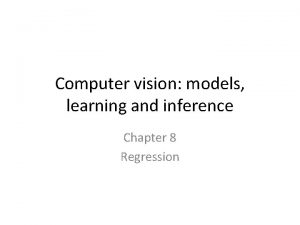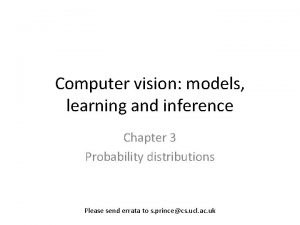Computer vision models learning and inference Chapter 2



















![Expectation tell us the expected or average value of some function f [x] taking Expectation tell us the expected or average value of some function f [x] taking](https://slidetodoc.com/presentation_image_h2/da4cc1dfa297e2dfd4456d22eee96b13/image-20.jpg)
![Expectation tell us the expected or average value of some function f [x] taking Expectation tell us the expected or average value of some function f [x] taking](https://slidetodoc.com/presentation_image_h2/da4cc1dfa297e2dfd4456d22eee96b13/image-21.jpg)






- Slides: 27

Computer vision: models, learning and inference Chapter 2 Introduction to probability Please send errata to s. prince@cs. ucl. ac. uk

Random variables • A random variable x denotes a quantity that is uncertain • May be result of experiment (flipping a coin) or a real world measurements (measuring temperature) • If we observe several instances of x we get different values • Some values occur more than others and this information is captured by a probability distribution Computer vision: models, learning and inference. © 2011 Simon J. D. Prince 2

Discrete Random Variables Computer vision: models, learning and inference. © 2011 Simon J. D. Prince 3

Continuous Random Variable Computer vision: models, learning and inference. © 2011 Simon J. D. Prince 4

Joint Probability • Consider two random variables x and y • If we observe multiple paired instances, then some combinations of outcomes are more likely than others • This is captured in the joint probability distribution • Written as Pr(x, y) • Can read Pr(x, y) as “probability of x and y” Computer vision: models, learning and inference. © 2011 Simon J. D. Prince 5

Joint Probability Computer vision: models, learning and inference. © 2011 Simon J. D. Prince 6

Marginalization We can recover probability distribution of any variable in a joint distribution by integrating (or summing) over the other variables Computer vision: models, learning and inference. © 2011 Simon J. D. Prince 7

Marginalization We can recover probability distribution of any variable in a joint distribution by integrating (or summing) over the other variables Computer vision: models, learning and inference. © 2011 Simon J. D. Prince 8

Marginalization We can recover probability distribution of any variable in a joint distribution by integrating (or summing) over the other variables Computer vision: models, learning and inference. © 2011 Simon J. D. Prince 9

Marginalization We can recover probability distribution of any variable in a joint distribution by integrating (or summing) over the other variables Works in higher dimensions as well – leaves joint distribution between whatever variables are left Computer vision: models, learning and inference. © 2011 Simon J. D. Prince 10

Conditional Probability • Conditional probability of x given that y=y 1 is relative propensity of variable x to take different outcomes given that y is fixed to be equal to y 1. • Written as Pr(x|y=y 1) Computer vision: models, learning and inference. © 2011 Simon J. D. Prince 11

Conditional Probability • Conditional probability can be extracted from joint probability • Extract appropriate slice and normalize Normalization: The sum of the row y* is not equal to 1 Computer vision: models, learning and inference. © 2011 Simon J. D. Prince 12

Conditional Probability • More usually written in compact form • Can be re-arranged to give Computer vision: models, learning and inference. © 2011 Simon J. D. Prince 13

Conditional Probability • This idea can be extended to more than two variables Computer vision: models, learning and inference. © 2011 Simon J. D. Prince 14

Bayes’ Rule From before: Combining: Re-arranging: Computer vision: models, learning and inference. © 2011 Simon J. D. Prince 15

Bayes’ Rule Terminology Likelihood – propensity for observing a certain value of x given a certain value of y Posterior – what we know about y after seeing x Prior – what we know about y before seeing x Evidence –a constant to ensure that the left hand side is a valid distribution Computer vision: models, learning and inference. © 2011 Simon J. D. Prince 16

Independence • If two variables x and y are independent then variable x tells us nothing about variable y (and vice-versa) • The rows resulting from cutting lines are proportional! Computer vision: models, learning and inference. © 2011 Simon J. D. Prince 17

Independence • If two variables x and y are independent then variable x tells us nothing about variable y (and vice-versa) • The rows resulting from cutting lines are proportional! Computer vision: models, learning and inference. © 2011 Simon J. D. Prince 18

Independence • When variables are independent, the joint factorizes into a product of the marginals: Computer vision: models, learning and inference. © 2011 Simon J. D. Prince 19
![Expectation tell us the expected or average value of some function f x taking Expectation tell us the expected or average value of some function f [x] taking](https://slidetodoc.com/presentation_image_h2/da4cc1dfa297e2dfd4456d22eee96b13/image-20.jpg)
Expectation tell us the expected or average value of some function f [x] taking into account the distribution of x Definition: Computer vision: models, learning and inference. © 2011 Simon J. D. Prince 20
![Expectation tell us the expected or average value of some function f x taking Expectation tell us the expected or average value of some function f [x] taking](https://slidetodoc.com/presentation_image_h2/da4cc1dfa297e2dfd4456d22eee96b13/image-21.jpg)
Expectation tell us the expected or average value of some function f [x] taking into account the distribution of x Definition in two dimensions: Computer vision: models, learning and inference. © 2011 Simon J. D. Prince 21

Expectation: Common Cases Computer vision: models, learning and inference. © 2011 Simon J. D. Prince 22

Expectation: Rules Rule 1: Expected value of a constant is the constant Computer vision: models, learning and inference. © 2011 Simon J. D. Prince 23

Expectation: Rules Rule 2: Expected value of constant times function is constant times expected value of function Computer vision: models, learning and inference. © 2011 Simon J. D. Prince 24

Expectation: Rules Rule 3: Expectation of sum of functions is sum of expectation of functions Computer vision: models, learning and inference. © 2011 Simon J. D. Prince 25

Expectation: Rules Rule 4: Expectation of product of functions in variables x and y is product of expectations of functions if x and y are independent Computer vision: models, learning and inference. © 2011 Simon J. D. Prince 26

Conclusions • Rules of probability are compact and simple • Concepts of marginalization, joint and conditional probability, Bayes rule and expectation underpin all of the models in this book • One remaining concept – conditional expectation – discussed later Computer vision: models, learning and inference. © 2011 Simon J. D. Prince 27
 Computer vision models learning and inference
Computer vision models learning and inference Computer vision models learning and inference
Computer vision models learning and inference Computer vision models learning and inference pdf
Computer vision models learning and inference pdf Computer vision: models, learning, and inference
Computer vision: models, learning, and inference Coordinate rotation matrix
Coordinate rotation matrix Camera models in computer vision
Camera models in computer vision Camera models in computer vision
Camera models in computer vision Structured light
Structured light What is the difference between models and semi models
What is the difference between models and semi models Cuadro comparativo de e-learning b-learning y m-learning
Cuadro comparativo de e-learning b-learning y m-learning Kubernetes gpgpu
Kubernetes gpgpu Concepts, techniques, and models of computer programming
Concepts, techniques, and models of computer programming Linear programming models graphical and computer methods
Linear programming models graphical and computer methods Mathematical foundations of computer graphics and vision
Mathematical foundations of computer graphics and vision Computer and robot vision
Computer and robot vision Self-paced learning for latent variable models
Self-paced learning for latent variable models Type of machine learning models
Type of machine learning models Geometric models in machine learning
Geometric models in machine learning Using inaccurate models in reinforcement learning
Using inaccurate models in reinforcement learning Inversion attacks
Inversion attacks Education styles
Education styles Stealing machine learning models via prediction apis
Stealing machine learning models via prediction apis Cmyk color model in computer graphics
Cmyk color model in computer graphics Parallel computer models
Parallel computer models Lighting models in computer graphics
Lighting models in computer graphics Computer graphics models are now commonly used for making
Computer graphics models are now commonly used for making Computational model in computer architecture
Computational model in computer architecture 1 crore in numbers
1 crore in numbers

